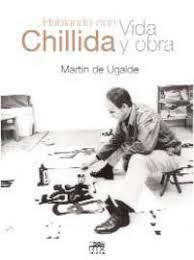
Idioma original: castellano
Year of publication: 1975
Valuation: recommended for interested parties
I suppose that almost everyone knows who Eduardo Chillida is, a Basque sculptor whose work, often of large dimensions, is spread across half the world, much of it in public spaces. For his part, with very few exceptions, Martín de Ugalde will be a completely unknown name to you. He is a writer who spent a good part of his life in exile, returning to Euskadi after the end of the Franco regime, when he acquired a certain notoriety as the author of books on Basque themes, including some of interviews with figures from the country, among whom he is included this text with the direct testimony of the artist.
Chillida’s life was also partially spent abroad, although for professional and not political reasons. His figure, widely recognized especially from the 70s of the last century, was however important long before, when he was part of Gaur, a group of Basque artists (Oteiza, Zumeta, Mendiburu…) who promoted a profound renewal of the plastic arts, transcending the local and national sphere. In the long talk the sculptor tells some family episodes and anecdotes about his works, but above all he talks about the creative process, the way of feeling and working with different materials, the search for the empty space that surrounds and is inserted in the object, or the intention of creating things that integrate into the environment and become public domain. Naturally, a lot of things to fill about 170 pages, although some matters are missed.
To begin with, although the book is republished several times, I deduce from the interview (because Ugalde does not say it) that it took place in 1975. By then, to give an example, the famous Peine del Viento in Donostia-San Sebastián was not yet standing. , the controversial emptying of the Tindaya mountain had not even been imagined, and the well-known scuffle with Oteiza was still a long way off. That is to say, the stage of, say, the artist’s greatest public visibility, and therefore perhaps the most attractive for the layman, is left out of the text, which thus focuses on a more intimate period and theme, with interesting but somewhat drier information. .
On the other hand, although I suppose that Martín de Ugalde will have worked on the interview beforehand, he cannot hide that his knowledge of art is quite limited. So most of the time he limits himself to continuing Chillida’s reflections, if not insisting, a little obsessively, on identity issues that in my opinion only have a relative weight in the sculptor’s work. When it comes to talking about art itself, Ugalde gets quite lost or gets around by resorting to intentionally abstract reasoning that not even the interviewee understands. By not conducting the conversation correctly, we miss some interesting facts about that initial stage in which Chillida advances in her maturation process.
Despite these shortcomings, we certainly find ideas of great interest, such as the insistence on separating creativity from technique, unlearning what is mastered in order to explore new paths, the relationship of the artist with the materials he uses, or the connection with his cultural environment. Because, although there are those who continue to think otherwise, to be a creator recognized throughout the world for decades it is not enough to invent a twisted iron or a mass of stone hanging from a cable: there are many hours of reflection and work, a lot of creativity trying to find the path between sketches, materials and discards. Let’s think about it a little when we see works that perhaps we don’t understand or that don’t tell us anything. Reading an intelligent and sensible guy like Chillida we can see it more clearly.
Source: https://unlibroaldia.blogspot.com/2024/09/martin-de-ugalde-hablando-con-chillida.html


